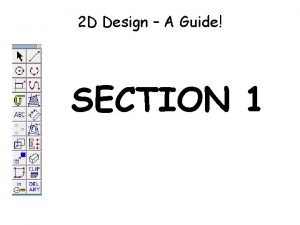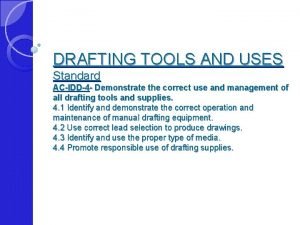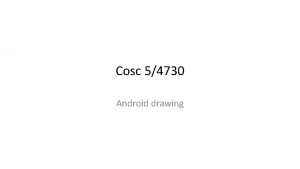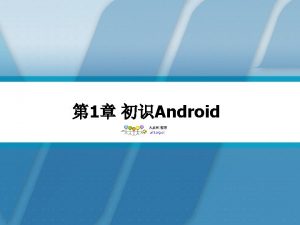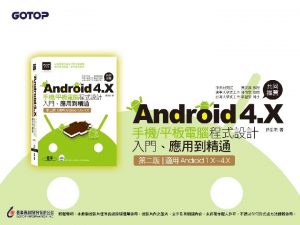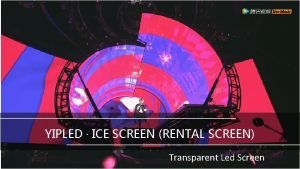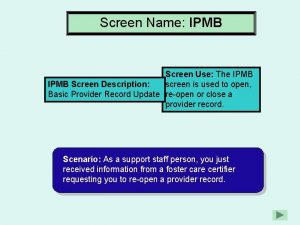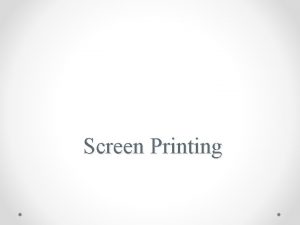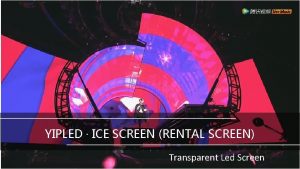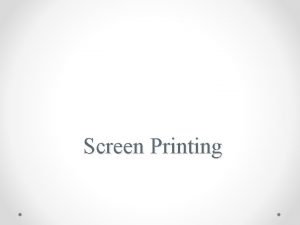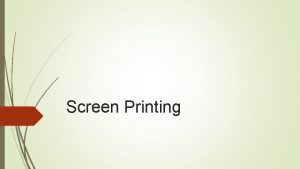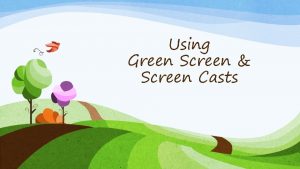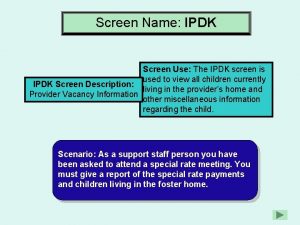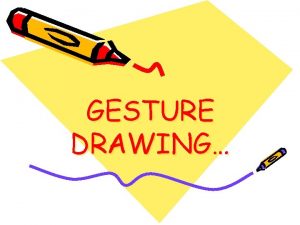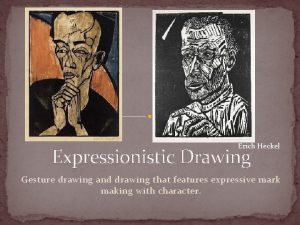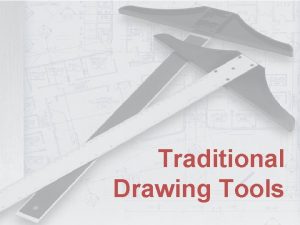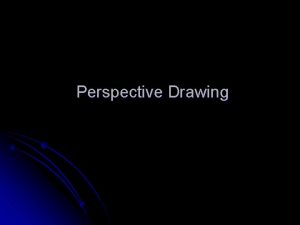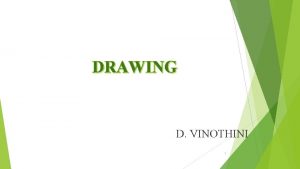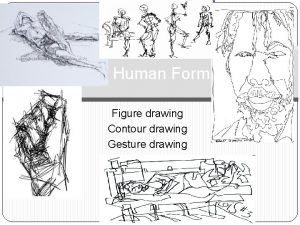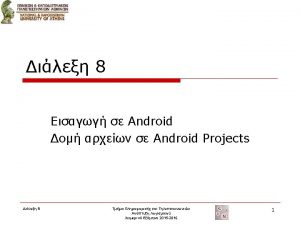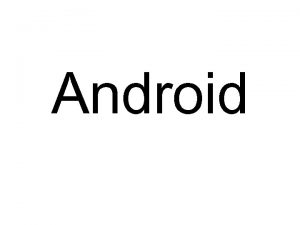Android drawing Screen support Android is the OS











![Points and lines • draw. Points (float[] pts, Paint paint) • draw. Points(float[] pts, Points and lines • draw. Points (float[] pts, Paint paint) • draw. Points(float[] pts,](https://slidetodoc.com/presentation_image/9d13fd718d91b6a61422db9e457289c2/image-12.jpg)
























- Slides: 36

Android drawing

Screen support • Android is the OS and is used a many different hardware created by different vendors. – Screen size • For simplicity, Android collapses all actual screen sizes into three generalized sizes: large, normal, and small – Resolution • The total number of physical pixels on a screen. Note that, although resolution is often expressed as width x height, resolution does not imply a specific aspect ratio. In Android, applications do not work directly with resolution. – Density • Based on the screen resolution, the spread of pixels across the physical width and height of the screen. • For simplicity, Android collapses all actual screen densities into three generalized densities: high, medium, and low.

Screen Size example

Screen support (2) • Dots-per-inch (DPI) – There are HIGH, MEDIUM, and LOW DPI, even with the same screen size. • In res: drawable-hdpi, drawable-mdpi, and drawable-ldpi and the system can • Density-independent pixel (dip) – A virtual pixel unit that applications can use in defining their UI, to express layout dimensions or position in a density-independent way. – The density-independent pixel is equivalent to one physical pixel on a 160 dpi screen, the baseline density assumed by the platform (as described later in this document). – At run time, the platform transparently handles any scaling of the dip units needed, based on the actual density of the screen in use. The conversion of dip units to screen pixels is simple: pixels = dips * (density / 160). – For example, on 240 dpi screen, 1 dip would equal 1. 5 physical pixels. – Using dip units to define your application's UI is highly recommended, as a way of ensuring proper display of your UI on different screens.

Why does it matter? • Same code to draw, 8 x 8 squares. Notice the difference even on the same emulator (screen: Hdpi WVGA 854).

Screen size and emulators Screen sizes and densities of emulator skins included in the Android SDK. Low density (120), ldpi Small screen QVGA (240 x 320) Normal screen WQVGA 400 (240 x 400) WQVGA 432 (240 x 432) Large screen Medium density (160), mdpi High density (240), hdpi HVGA (320 x 480) WVGA 800 (480 x 800) WVGA 854 (480 x 854) WVGA 800* (480 x 800) WVGA 854* (480 x 854) * To emulate this configuration, specify a custom density of 160 when creating an AVD that uses a WVGA 800 or WVGA 854 skin.

API versions. • Skipping the Min SDK version also effects the drawing. – Screen is much smaller resolution of 320 x 480 even with a larger screen size – While using Min SDK version 8, gives you the whole resolution of 480 x 854 (droid screen size)

And supporting the "notch" • https: //android-developers. googleblog. com/2018/07/supportingdisplay-cutouts-on-edge-to. html • Android calls them cutouts and it limited to only one cutout per side and only the top and bottom. No cutouts on the left/right in portrait mode. (so a max of 2 per screen) – Basically it works without making any changes. But if you go full screen and/or use raw. X/Y coordinates you will need to account the cutouts. – See the blog post above for more info.

Drawing • In Android, you draw “on something”, instead of on a screen. • This is not Open. GL, instead a native graphics package. – The canvas of an image in the gui lecture – Canvas is what you draw on. You get a canvas of the “widget” you are drawing on. • Generally: custom View, Surface. View, or image. – You draw with a “brush”, that android calls a Paint object. – We cover the Canvas first, then how each of those work.

Canvas • Everything is drawn with the canvas object – assume canvas. in front of these methods. – draw. Color(int color) • Fills the entire canvas with specified color. • To clear the canvas with white – draw. Color(Color. WHITE) – draw. Paint(Paint paint) • Fill the entire canvas with the specified paint. • like draw. Color, but uses a Paint object. – draw. Point(float x, float y, Paint paint) • for drawing a single point. – Note the Float x and y • Paint can be thought of a brush, that has color and style

Paint object • a brush, that has color and style – Paint black = new Paint() – black. set. Color(); //default is black – Black. set. Color(Color. Black); • Color is another class, with predefined colors, but only contains: – BLACK, BLUE, CYAN, DKGRAY, GREEN, LTGRAY, MAGENTA, RED, TRANSPARENT, WHITE, YELLOW – black. set. Style(Paint. Style. STROKE); • Paint. Style. STROKE for outlines (like lines) • Paint. Style. FILL for filled (such as filled rectangles) • example: – draw. Point(1. 0, black); //draw a black point at 1, 1
![Points and lines draw Points float pts Paint paint draw Pointsfloat pts Points and lines • draw. Points (float[] pts, Paint paint) • draw. Points(float[] pts,](https://slidetodoc.com/presentation_image/9d13fd718d91b6a61422db9e457289c2/image-12.jpg)
Points and lines • draw. Points (float[] pts, Paint paint) • draw. Points(float[] pts, int offset, int count, Paint paint) – Draw a series of points. – pts • Array of points to draw [x 0 y 0 x 1 y 1 x 2 y 2. . . ] • draw. Line(float start. X, float start. Y, float stop. X, float stop. Y, Paint paint) – Draw a line segment with the specified start and stop x, y coordinates, using the specified paint. • draw. Lines(float[] pts, Paint paint) • draw. Lines(float[] pts, int offset, int count, Paint paint) – Draw a series of lines. – pts • Array of points to draw [x 0 y 0 x 1 y 1 x 2 y 2. . . ] • draw. Path(Path path, Paint paint) – Draw the specified path using the specified paint.

Rectangles • draw. Rect(Rect. F rect, Paint paint) – Draw the specified Rect using the specified paint. • draw. Rect(float left, float top, float right, float bottom, Paint paint) – Draw the specified Rect using the specified paint. • draw. Rect(Rect r, Paint paint) – Draw the specified Rect using the specified Paint. • draw. Round. Rect(Rect. F rect, float rx, float ry, Paint paint) – Draw the specified round-rect using the specified paint.

circles and ovals • draw. Circle(float cx, float cy, float radius, Paint paint) – Draw the specified circle using the specified paint. • draw. Arc(Rect. F oval, float start. Angle, float sweep. Angle, boolean use. Center, Paint paint) – Draw the specified arc, which will be scaled to fit inside the specified oval. • draw. Oval(Rect. F oval, Paint paint) – Draw the specified oval using the specified paint.

Drawing images • draw. Bitmap(Bitmap bitmap, float left, float top, Paint paint) – Draw the specified bitmap, with its top/left corner at (x, y), using the specified paint, transformed by the current matrix. • draw. Bitmap(Bitmap bitmap, Rect src, Rect. F dst, Paint paint) – Draw the specified bitmap, scaling/translating automatically to fill the destination rectangle. • draw. Picture(Picture picture, Rect dst) – Draw the picture, stretched to fit into the dst rectangle.

Loading images. • Assuming the images are in the drawable (or drawable-*) directory • Bitmap bg = Bitmap. Factory. decode. Resource( get. Resources(), R. drawable. bg ); – Where R. drawable. bg is the id of the image you want to load.

Drawing Text • draw. Text(String text, float x, float y, Paint paint) – Draw the text, with origin at (x, y), using the specified paint. • draw. Text(String text, int start, int end, float x, float y, Paint paint) – Draw the text, with origin at (x, y), using the specified paint. • draw. Text. On. Path(String text, Path path, float h. Offset, float v. Offset, Paint paint) – Draw the text, with origin at (x, y), using the specified paint, along the specified path. • The text will follow the path, including angles down. • draw. Pos. Text(String text, float[] pos, Paint paint) – Draw the text in the array, with each character's origin specified by the pos array. – pos is an Array of [x, y] positions, used to position each character

Text and Paint • How the font is drawn is controlled with the paint object – Paint black = new Paint() – black. set. Color(Color. BLACK); – So to change the font size and make it twice the default size • black. set. Text. Size(black. get. Text. Size()*2); • See the Android. graphics Paint for more methods.

other interesting methods. • You can scale, skew, rotate, and translate – using the set. Matrix(…), scale(…), rotate(…), translate(…) and skew(…) methods. • And many other methods I skipped over.

Paint and Color • The Color class has very few colors – BLACK, BLUE, CYAN, DKGRAY, GREEN, LTGRAY, MAGENTA, RED, TRANSPARENT, WHITE, YELLOW – But you can “create” more colors. – Say we want purple, we can use Color. rgb() – Using http: //cloford. com/resources/colours/500 col. htm • Paint purple = new Paint() • purple. set. Color(Color. rgb(128, 0, 128)); • Now we can “draw” with a purple color.

Canvas • Not a complete list, see • http: //developer. android. com/reference/android/graphics/Ca nvas. html

Images • You can get a blank Bitmap or Image and then draw on them. Bitmap e. Bitmap= e. Bitmap = Bitmap. create. Bitmap(x, y, Bitmap. Config. ARGB_8888); – Where x and y are the size of the image to create. Canvas e. Canvas = new Canvas(e. Bitmap); e. Canvas. draw. Color(Color. WHITE); //white screen Paint black = new Paint(Color. BLACK); //black paintbrush e. Canvas. draw. Rect(0, 0, x, y, black); e. Canvas. Draw. Text(“Hi there”, 10. 0, black); • And display the image in a Image. View or other image widget – Use invalidate() method for the image. View, so it is redrawn.

custom View • Using a custom View, you can use the whole screen or only part as you need. – create the my. View constructor. – Override the on. Draw method and you are ready to draw. class my. View extends View { public my. View(Context context) { super(context); } @Override protected void on. Draw(Canvas canvas) { } } • Remember you can override many other methods as well.

custom View (2) • Displaying a custom View. • If your view is the only widget on the screen, then you can skip the layout and use something like this in On. Create(…) them public void on. Create(Bundle saved. Instance. State) { super. on. Create(saved. Instance. State); mv = new my. View(this); set. Content. View(mv); mv. request. Focus(); }

custom View (3) • If it is one of many widgets, then you need a layout. In the layout, it would look something like this: <view class=“edu. test. my. View" android: id="@+id/my. View 01" android: layout_width="wrap_content" android: layout_height="wrap_content"/> • If it’s a sub class of your activity: Note the $ <view class=“edu. test. main$my. View" android: id="@+id/View 01" android: layout_width="wrap_content" android: layout_height="wrap_content"/> – Also the my. View class needs to be declared static.

SURFACEVIEW AND TEXTVIEW

Surface. View • Similar in nature to a View – Intended more for games – We come back to surface. View again with Open. GL. • extend the Surface. View and implement Surface. Holder. Callback – The reason we need the Surface. Holder is to provide us with the canvas we can draw on. – The Surface. Holder. Callback interface requires 3 additional methods we need to implement: surface. Created(), surface. Destroyed(), surface. Changed() • and the constructor for Surface. View

Surface. View (2) • It will look something like this: class my. Surface. View extends Surface. View implements Surface. Holder. Callback { public my. Surface. View(Context context) { super(context); get. Holder(). add. Callback(this); } @Override public void surface. Changed(Surface. Holder holder, int format, int width, int height) { // TODO Auto-generated method stub } @Override public void surface. Created(Surface. Holder holder) { // TODO Auto-generated method stub } @Override public void surface. Destroyed(Surface. Holder holder) { // TODO Auto-generated method stub } }

Surface. Holder. Callback • surface. Created – called when the surface is created. A good place to setup stuff • surface. Destroyed – called when the surfaced is destroyed. need to close down anything. We can’t touch the surface/canvas once this has been called. • surface. Changed – likely called when screen flipping or other change to the surface. I’ve left this method blank in the code.

a Thread • The next thing we need is a thread to control the drawing. – extend the thread class and create a constructor to pass the surfaceholder and surfaceview too.

Thread Example class my. Thread extends Thread { private Surface. Holder _surface. Holder; private my. Surface. View _my. Surface. View; private boolean _run = false; } public my. Thread(Surface. Holder surface. Holder, my. Surface. View) { _surface. Holder = surface. Holder; _my. Surface. View = Surface. View; } public void set. Running(boolean run) { _run = run; } @Override public void run() { while (_run) { //now code for drawing… } }

locking the surface. Holder • before we draw, we need to make sure we change a sync lock on the surface. Holder Canvas c; while (_run) { c = null; try { c = _surface. Holder. lock. Canvas(null); synchronized (_surface. Holder) { _my. Surface. View. on. Draw(c); //finally we can draw now. } } finally { // do this in a finally so that if an exception is thrown // during the above, we don't leave the Surface in an // inconsistent state if (c != null) { _surface. Holder. unlock. Canvas. And. Post(c); } } }

Back to Surface. View • We start the thread in surface. Created public void surface. Created(Surface. Holder holder) { mythread. set. Running(true); mythread. start(); } • end the thread in surface. Destroyed public void surface. Destroyed(Surface. Holder holder) { boolean retry = true; mythread. set. Running(false); while (retry) { try { mythread. join(); retry = false; } catch (Interrupted. Exception e) { // we will try it again and again. . . } } }

Surface • Handle into a raw buffer that is being managed by the screen compositor – as an output destination for the android. hardware. camera 2, Media. Codec, Media. Player, and Allocation APIs (including Open. GL ES) • The surface is displayed via – android. view. Surface. View (API 1+) – android. view. Texture. View (API 14+)

Surface. View and Texture. View • A Surface. View and Texture. View can be used to display a content stream. – Such a content stream can for instance be a video, Camera, or an Open. GL scene. The content stream can come from the application's process as well as a remote process. – We can get a canvas for it and draw on the canvas as well. • Texture. View can only be used in a hardware accelerated window. When rendered in software, Texture. View will draw nothing. • Unlike Surface. View, Texture. View does not create a separate window but behaves as a regular View. This key difference allows a Texture. View to be moved, transformed, animated, etc.

Declaring/using • For a Surfaceview we need a "implements Surface. Holder. Callback" sv = find. View. By. Id(R. id. surfaceview); sv. get. Holder(). add. Callback(this) • Where this is: (Suface. Holder. Callback) //called when surface is created public void surface. Created(Surface. Holder holder) { //start whatever will draw/user the surface } //called when the surfaceview has changed size. @Override public void surface. Changed(Surface. Holder holder, int format, int width, int height) { } //called when surfaceview is done. public void surface. Destroyed(Surface. Holder holder) { } For a Texture. View we need a "implements Texture. View. Surface. Texture. Listener" tv = sv = find. View. By. Id(R. id. textureview); tv. set. Surface. Texture. Listener(this) • Where this is: (Surface. Texture. Listener) //called when surface is ready to use public void on. Surface. Texture. Available(Surface. Texture surface, int width, int height) { //start whatever will draw/user the surface } //called when textureview has changed sized. public void on. Surface. Texture. Size. Changed( Surface. Texture surface, int width, int height) { } //called when textview is done public boolean on. Surface. Texture. Destroyed( Surface. Texture surface) { } //Invoked when the specified Surface. Texture is updated through update. Tex. Image(). public void on. Surface. Texture. Updated( Surface. Texture surface) { } • Note, if you forget the method in RED, nothing will happen.
 Screen small screen offscreen
Screen small screen offscreen Screen drawing tool
Screen drawing tool Signal word
Signal word Create a flipbook of drafting materials/tools/equipment
Create a flipbook of drafting materials/tools/equipment Cái miệng xinh xinh thế chỉ nói điều hay thôi
Cái miệng xinh xinh thế chỉ nói điều hay thôi Hát kết hợp bộ gõ cơ thể
Hát kết hợp bộ gõ cơ thể Mật thư tọa độ 5x5
Mật thư tọa độ 5x5 Từ ngữ thể hiện lòng nhân hậu
Từ ngữ thể hiện lòng nhân hậu Tư thế ngồi viết
Tư thế ngồi viết Thế nào là giọng cùng tên? *
Thế nào là giọng cùng tên? * Voi kéo gỗ như thế nào
Voi kéo gỗ như thế nào Thẻ vin
Thẻ vin Thể thơ truyền thống
Thể thơ truyền thống Khi nào hổ mẹ dạy hổ con săn mồi
Khi nào hổ mẹ dạy hổ con săn mồi Thế nào là hệ số cao nhất
Thế nào là hệ số cao nhất Diễn thế sinh thái là
Diễn thế sinh thái là Lp html
Lp html Vẽ hình chiếu vuông góc của vật thể sau
Vẽ hình chiếu vuông góc của vật thể sau 101012 bằng
101012 bằng Lời thề hippocrates
Lời thề hippocrates Vẽ hình chiếu đứng bằng cạnh của vật thể
Vẽ hình chiếu đứng bằng cạnh của vật thể Tư thế worms-breton
Tư thế worms-breton đại từ thay thế
đại từ thay thế Quá trình desamine hóa có thể tạo ra
Quá trình desamine hóa có thể tạo ra Sự nuôi và dạy con của hổ
Sự nuôi và dạy con của hổ Thế nào là mạng điện lắp đặt kiểu nổi
Thế nào là mạng điện lắp đặt kiểu nổi Các châu lục và đại dương trên thế giới
Các châu lục và đại dương trên thế giới Dạng đột biến một nhiễm là
Dạng đột biến một nhiễm là Bổ thể
Bổ thể Thế nào là sự mỏi cơ
Thế nào là sự mỏi cơ độ dài liên kết
độ dài liên kết Thiếu nhi thế giới liên hoan
Thiếu nhi thế giới liên hoan Fecboak
Fecboak Chúa yêu trần thế alleluia
Chúa yêu trần thế alleluia điện thế nghỉ
điện thế nghỉ Một số thể thơ truyền thống
Một số thể thơ truyền thống Trời xanh đây là của chúng ta thể thơ
Trời xanh đây là của chúng ta thể thơ

